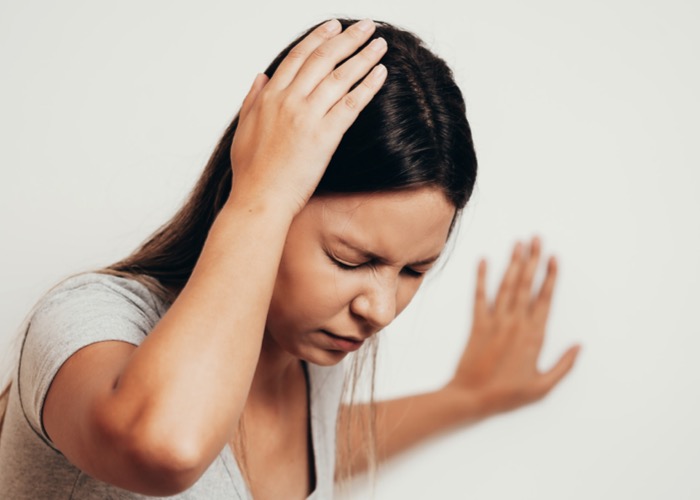No more headaches
In Common conditions
Follow this topic
Bookmark
Record learning outcomes

According to a OnePoll survey on behalf of Nurofen, the average person gets up to two headaches a week, with one in five saying it causes emotional stress or time off work, writes Sarah Purcell. A headache typically lasts about three and a half hours, yet more than half of those surveyed said they preferred to wait and see if a headache got better before treating it. Those who do use an analgesic may not be using the most effective one for their headache type. More than half of people believe all OTC painkillers work in the same way.
A study by the University of Warwick has found that people with persistent headache or low back pain are twice as likely to suffer both disorders. The results suggest an association between the two types of pain that could point to shared treatment for both, say the authors. The association is even more likely in migraine sufferers. About one in five has low back pain and one in 30 has chronic headache. The study found that one in 100 people in the UK has both.
“There may be something in the relationship between how people react to pain that makes some people more sensitive to both the physical causes of the headache, particularly migraine, and the physical causes in the back and how the body reacts to that and how you become disabled by it,” says Professor Martin Underwood of Warwick Medical School.
The pharmacy role
Ebrahim Aziz, Alphega Pharmacy member at Berrymoor Pharmacy in Wellingborough, says following the medicines protocol and WWHAM, for every patient is crucial. “If you follow WWHAM, you should easily be able to classify what sort of headache the patient has, but I like my team to double check their recommended course of action with me first,” he says. “I remind my team that the questions may not gather all the information required and further questioning may be needed. They need to consider lifestyle factors, too. Is there a lack of sleep or an increase in caffeine intake? Are they a shift worker? Are they suffering from stress or family issues? For me, the most important question to ask is what medication they take. A patient may be using opioid painkillers, which can cause secondary headaches if not used properly. Or they may be on medication that can cause secondary headaches, and we can advise them on this.”
Improving sales
Rob Booth, senior category buyer, analgesics, at Well Pharmacy says: “It’s essential to have a complete range that contains all products and brands that a customer would expect to see in a pharmacy. Some brands offer a unique ingredient combination while others are also available in tertiary or own label, offering a great saving to customers. Own label pain relief continues to be a rapidly growing sector as customers look for more cost effective solutions.”
“Customers searching the pain relief category are often already suffering, so it’s important that the pain relief categories both on the shop floor and behind the counter are clearly signposted,” says Ms Crossthwaite. “Feature multiple facings of leading brands at eye level, to the left of the fixture to help with navigation. Customers have multiple decision branches when searching the category, including brand, core ingredient, pack size and formulation. Merchandising your category based on these decisions will help with the navigation and customer choice.”
“Promote the knowledge of your team in this area,” says Mr Aziz. “If they are confident and show empathy, the customer will trust them and purchase or consider recommendations made. For customers who are self-selecting, it’s the role of the team to ensure the product is right for the customer’s symptoms and look to educate them on alternatives. Follow planograms provided by your supplier and update them on a regular basis.”
Numark pharmacy services manager Lucy Morris says it’s important to ask questions to establish whether your customer has a headache or a migraine so you can recommend appropriate treatment. “Find out about potential causes or triggers so you can help prevent recurrence,” she says. “Refer any red flags such as a recent head injury, confusion/vomiting, worsening headache with fever, sudden onset or migraine-type symptoms for the first time. Pharmacy staff can help identify customers who frequently buy OTC painkillers for headaches and discuss the potential impact of rebound headaches with them.”
Pharmacy staff can discuss the potential impact of rebound headaches with customers who frequently buy OTC painkillers
Headache uncovered
A headache can be primary or secondary. Primary headache is the most common (90 per cent of cases), with tension headache and migraine being the most common forms. Secondary headache is a symptom of a separate illness or injury, such as a head injury, stroke, substance misuse, infection, disorders of the neck, eyes, sinus or teeth.
A cross-sectional EU study found the lifetime prevalence of headache is 91.3 per cent. The three most common types of headache are tension (40 per cent), migraine (10 per cent) and cluster (1 to 2 per cent).
The headache and migraine treatment market
Numark says the total pain relief category holds 27 per cent of the total medicines market within pharmacy. “Some 78 per cent of this is P medicines, which creates a clear point of difference for pharmacy compared with other retailers who can only supply GSL medicines,” says Cathy Crossthwaite, Numark marketing co-ordinator.
Mr Aziz says migraine is the most important category for his pharmacy and he has noticed increasing requests for sumatriptan. “Patients who are being prescribed sumatriptan often purchase these as they have either run out or can’t get in to see their GP,” he says.
According to Mintel (OTC Analgesics, May 2019), the only analgesic format to fall in use over the past year is combination tablets/capsules such as co-codamol. Mintel says this is likely to be due to concerns over potential addiction. According to a survey by Mintel, in the past year, 75 per cent of respondents have used paracetamol tablets/capsules for pain relief, 61 per cent ibuprofen, 22 per cent combination tablets/capsules, 16 per cent aspirin, 11 per cent powder/soluble formats and 9 per cent liquid formats.
Market research provider Euromonitor International says the systemic analgesics market in the UK is forecast at £561m for 2019, up from £546m in 2018, an increase of 2.4 per cent year on year.
Tension headache
Most of us will experience a tension headache at some time. About half of adults get them at least every month and one in 30 people has chronic tension headache (more than 15 days a month for more than three months). These headaches typically peak from age 20 to 40 and women are slightly more affected at a ratio of 5:4 compared with men.
Tension headache is usually experienced on both sides of the head and is often described as a tight band around the head. It can last from minutes to days. It’s a dull ache rather than a throbbing pain. Pain is not made worse by daily activities and sufferers can usually continue as normal. The causes are not clear, but they can be triggered by tension, anxiety, stress and tiredness.
It is important to talk to your customer about possible triggers and how they can avoid these. Taking more exercise often helps, as does reducing caffeine intake and drinking more water. Other lifestyle factors that can help include replacing high pillows with flat ones, getting enough sleep and not reading in low lighting.
Treatment of tension headache
Analgesics work well in easing tension headaches. NICE recommends paracetamol or ibuprofen, depending on what best suits the patient. It doesn’t recommend offering opioids. “If headaches are mild and infrequent, there is nothing to worry about,” says Dr Fayyaz Ahmed, spokesperson for the British Association for the Study of Headache and consultant neurologist at Hull Royal Infirmary. “Use simple painkillers such as paracetamol and ibuprofen. If they become more frequent and moderate to severe, see the GP. Do not use painkillers with codeine or caffeine.” There is a risk of medication overuse developing in patients with chronic tension headache. “Anyone using painkillers on more than two days a week on a regular basis has a risk of developing headaches due to painkillers,” he says. “Pharmacy staff should be warning patients that if they require the painkiller that frequently they should see their GP.”
Red flags
“If someone is diagnosed with tension headache, there are no red flags,” says Dr Ahmed. “However, if they haven’t had a diagnosis and display any of the following, they should seek urgent advice: sudden onset of headache as if they have been hit with a cricket bat; recent onset of headache and getting worse; headache worse on lying down, coughing, sneezing or bending forward; headache of recent onset in those aged 50 plus or previous diagnosis of cancer; headache associated with fever, drowsiness or loss of vision.”
Cluster headache
Cluster headache (CH) is thought to be the most painful condition known to mankind. Pain is focused around the eye socket and temple and stays on one side during an attack. Episodic CH attacks occur on a daily basis over weeks or months and then stop for a length of time before returning. In chronic CH, attacks occur regularly with remission of less than four weeks. Typical age of onset is 20 to 40 and 70 per cent are affected before the age of 30. Men are four times more likely to be affected than women.
Cluster headache affects 0.1 per cent of the population in any year. “While it’s not getting any more common, it is being diagnosed more often as doctors and patients are becoming more aware of the symptoms,” says Professor Peter Goadsby, spokesperson for the charity Ouch and director of the NIHR/Wellcome Trust King’s Clinical Research Facility at King’s College Hospital, London. “We still don’t know what causes it, but there does seem to be a genetic link.”
Anyone using painkillers on more than two days a week on a regular basis has a risk of developing headaches
As well as severe pain, other common symptoms include red/watery eye, runny/blocked nose, drooping or swollen eyelid, constricted pupil, flushing/facial sweating and restlessness. Attacks last between 15 minutes and three hours and can occur up to eight times a day if not treated.
Before an attack, many CH sufferers have similar signs to a migraine – tiredness and yawning, feeling sick or being sick and sensitivity to light, smells and sounds. However, nine in 10 sufferers are restless and irritable during an attack, which is different from how migraine sufferers react.
A diagnosis is important for correct treatment. “Cluster is often misdiagnosed as migraine in women,” says Professor Goadsby. “In men with symptoms, two-thirds are sent to a dentist, as pain is often in the upper jaw too, 20 per cent get referred to an ENT specialist and 20 per cent to an eye specialist. It’s often misdiagnosed as a sinus problem. One of the main signs of CH is that bouts will occur at the same times of year and same time of day or night.”
Treatment of cluster headache
First line treatment for CH is sumatriptan injection. High-flow oxygen is the other main treatment.
Preventive drugs may be used to reduce the number of attacks. Short-term preventives include steroids (prednisolone) used for two to three weeks at a time. For sufferers who need longer-term preventives, verapamil or lithium are prescribed.
A new hand-held device that emits a low level electric current to disrupt pain signals is now being funded by the NHS. The device is applied to the vagus nerve in the neck.
Medication-overuse headache
People who use analgesics more than two or three times a week or for more than 10 days a month to treat headache and migraine can develop medication-overuse headache. This is a rebound headache that occurs when each dose of analgesic wears off. It can be caused by any painkiller. It is diagnosed when headache occurs more than 15 days a month for three or more months in someone with existing headache disorder.
“About 1 to 2 per cent of the population are affected and it’s partly because of the easy availability of painkillers OTC, especially those with codeine and caffeine in them,” says Dr Ahmed. “Those with anxiety and depression, and migraine sufferers, are more prone. Anyone using painkillers more than twice a week on a regular basis has a risk of developing medication-overuse headache.”
“Over the years I have seen a gradual increase in the number of people using stronger pain medication for headache,” says Mr Aziz. “I regularly look out for customers who attempt to buy the item more than once a fortnight and try to offer alternatives, including lifestyle advice or a GP referral. In some cases you find that customers who have an addiction problem have rehearsed their answers, which may be a sign they are misusing their medication. Look out for patients who give all the answers even before you get a chance to ask them the questions.”
Symptoms are a headache that develops within a day or so of the last dose of an analgesic and with a further withdrawal headache occurring after the next dose. Headaches tend to be worse first thing in the morning and after exercise.
Treatment of medication-overuse headache
Customers should be referred to their GP for diagnosis and to rule out any secondary causes, including cranial or vascular disorders, intracranial hypertension, infection, such as meningitis, or trigeminal neuralgia.
Withdrawal from analgesics is the only way to treat it. Headaches often worsen initially and may take several weeks to improve. Patients can reintroduce analgesics after two months, with clear restrictions on frequency of use.
Migraine
Migraine is the third most common disease worldwide and affects one in seven people. Three times as many women are affected as men. There are an estimated 190,000 attacks each day in the UK, says the Migraine Trust. They usually begin in puberty and most commonly affect those aged 25 to 55.
It is often inherited and has a genetic basis, but remains undiagnosed in at least 50 per cent of people.
“Current understanding suggests there is activation of the pain-sensitive structures and of trigeminal cranial and intracranial nerve fibres,” says Ria Bhola, migraine nurse at the Migraine Trust. “Changes in brain chemistry and the release of neurotransmitters are thought to play a role.”
Most common symptoms include a one-sided, throbbing headache, sensitivity to light and noise, feeling or being sick and lethargy. Attacks can last from four to 72 hours. Some sufferers experience an aura phase before the headache, which includes visual signs, pins and needles or numbness and speech difficulty.
Advice for pharmacy staff
Ria Bhola, migraine nurse at the Migraine Trust says pharmacy staff should be passing on the following to their customers. “Diagnosis is important,” she says. “This drives the therapy and lifestyle advice and ensures patients are treated correctly. It’s also important that they have appropriate treatment, for example a preventive to reduce frequency and severity of migraine and minimise the risk of medication overuse. Be ready to offer appropriate acute treatments to customers. Pharmacists should also advise on the use of triptans, NSAIDs, avoiding opiates, taking preventives for an appropriate length of time and dosing for best effect. They should educate and reinforce the medication-overuse headache complication of treatments.”
Treatment of migraine
Some sufferers will get relief from simple analgesics, and these are best taken in soluble form. Care needs to be taken with combination products that include caffeine or codeine as there is increased risk of misuse. Anti-emetics can help with nausea.
Triptans relieve pain by narrowing blood vessels and blocking transmission of pain signals. Preventive medicines may be recommended for patients who have four or more attacks a month. Beta blockers and anti-convulsants are commonly used. The newest preventive treatment is calcitonin gene-related peptide (CGRP) pathway monoclonal antibodies, such as Aimovig. These work by relaxing blood vessels and inactivating the CGRP molecules associated with migraine. It’s available on the NHS in Scotland, but was recently rejected by NICE.
P3pharmacy category panel
 Lila Thakerar, Shaftesbury Pharmacy, Harrow
Lila Thakerar, Shaftesbury Pharmacy, Harrow
“Lots of our customers ask for advice about headaches. They usually ask what we recommend and how often they should take it. Nurofen and Syndol are popular. OTC sumatriptan – Migraitan – is gaining in popularity. It may be a customer has already had a prescription for sumatriptan and it’s more convenient to buy it from their pharmacy. It’s important to promote new brands and launches. There are many new products, some with the same ingredients. Use leaflets, posters and dummy packs to show customers what you stock, and make sure staff are well trained.”
 Mital Thakrar, Well Pharmacy, Birmingham
Mital Thakrar, Well Pharmacy, Birmingham
“OTC treatment is important for a range of different headaches. People present daily with headaches. Understanding key OTC painkillers and the ingredients in each product and what their function is can really help patients alleviate their symptoms. The biggest opportunity to grow this category is to upskill team members to be able to recognise symptoms, ask the right questions and be able to understand the range of medicines available in the pharmacy. We can then advise patients and grow our relationships with them further to ensure repeat custom.”
 Melissa Liew, Ellacombe Pharmacy, South Gloucestershire
Melissa Liew, Ellacombe Pharmacy, South Gloucestershire
“People want something that works quickly. We need to have a more holistic approach than in the past. Most headache sufferers don’t understand the cause of their headache and don’t necessarily know the difference between a headache and a migraine. We should encourage people to talk about their symptoms so we can give the right advice. We have a healthy trade in migraine products, such as Migraleve, and general analgesics. There are a few people who are habitual analgesic users, so it’s important to look out for repetitive sales and refer them to their GP if necessary.”
